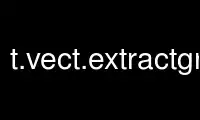
This is the command t.vect.extractgrass that can be run in the OnWorks free hosting provider using one of our multiple free online workstations such as Ubuntu Online, Fedora Online, Windows online emulator or MAC OS online emulator
PROGRAM:
NAME
t.vect.extract - Extracts a subset of a space time vector dataset.
KEYWORDS
temporal, extract, vector, time
SYNOPSIS
t.vect.extract
t.vect.extract --help
t.vect.extract [-n] input=name [where=sql_query] [expression=sql_query] output=name
[layer=string] [type=string[,string,...]] [basename=string] [nprocs=integer]
[--overwrite] [--help] [--verbose] [--quiet] [--ui]
Flags:
-n
Register empty maps
--overwrite
Allow output files to overwrite existing files
--help
Print usage summary
--verbose
Verbose module output
--quiet
Quiet module output
--ui
Force launching GUI dialog
Parameters:
input=name [required]
Name of the input space time vector dataset
where=sql_query
WHERE conditions of SQL statement without ’where’ keyword used in the temporal GIS
framework
Example: start_time > ’2001-01-01 12:30:00’
expression=sql_query
WHERE conditions of SQL statement without ’where’ keyword
Example: income < 1000 and inhab >= 10000
output=name [required]
Name of the output space time vector dataset
layer=string
Layer number or name
Vector features can have category values in different layers. This number determines
which layer to use. When used with direct OGR access this is the layer name.
Default: 1
type=string[,string,...]
Input feature type
Options: point, line, boundary, centroid, area
Default: point,line,boundary,centroid,area
basename=string
Basename of the new generated output maps
A numerical suffix separated by an underscore will be attached to create a unique
identifier
nprocs=integer
The number of v.extract processes to run in parallel. Use only if database backend is
used which supports concurrent writing
Default: 1
DESCRIPTION
The purpose of t.vect.extract is to extract a subset of a space time vector dataset and to
store that subset in a different space time vector dataset.
EXAMPLE
In the following example a new space time vector dataset will be create with all the data
later than 2000:
t.vect.extract input=shoreline where="start_time > 2000" \
output=shoreline_later_2000 basename=new_shoreline
t.info shoreline_later_2000@shoreline type=stvds
+-------------------- Space Time Vector Dataset -----------------------------+
| |
+-------------------- Basic information -------------------------------------+
| Id: ........................ shoreline_later_2000@shoreline
| Name: ...................... shoreline_later_2000
| Mapset: .................... shoreline
| Creator: ................... lucadelu
| Temporal type: ............. relative
| Creation time: ............. 2014-11-29 08:43:50.043219
| Modification time:.......... 2014-11-29 08:43:50.085407
| Semantic type:.............. mean
+-------------------- Relative time -----------------------------------------+
| Start time:................. 2003
| End time:................... 2009
| Relative time unit:......... years
| Granularity:................ 1
| Temporal type of maps:...... point
+-------------------- Spatial extent ----------------------------------------+
| North:...................... 1039175.31479
| South:...................... 34705.216018
| East:.. .................... 3052322.44671
| West:....................... 2130004.16779
| Top:........................ 0.0
| Bottom:..................... 0.0
+-------------------- Metadata information ----------------------------------+
| Vector register table:...... vector_map_register_8395740fc8de42149fef74a3d25bbb05
| Number of points ........... 0
| Number of lines ............ 407
| Number of boundaries ....... 0
| Number of centroids ........ 0
| Number of faces ............ 0
| Number of kernels .......... 0
| Number of primitives ....... 407
| Number of nodes ............ 767
| Number of areas ............ 0
| Number of islands .......... 0
| Number of holes ............ 0
| Number of volumes .......... 0
| Number of registered maps:.. 3
|
| Title:
| North Carolina shoreline
| Description:
| North Caroline shoreline from 2000 to 2009
| Command history:
| # 2014-11-29 08:43:50
| t.vect.extract input="shoreline"
| where="start_time > 2000" output="shoreline_later_2000"
| basename="new_shoreline"
| # 2014-11-29 08:44:14
| t.support type="stvds"
| input="shoreline_later_2000@shoreline"
| descr="North Caroline shoreline from 2000 to 2009"
+----------------------------------------------------------------------------+
t.vect.list shoreline_later_2000
name|layer|mapset|start_time|end_time
shoreline_2003|None|shoreline|2003|None
shoreline_2004|None|shoreline|2004|None
shoreline_2009|None|shoreline|2009|None
Use t.vect.extractgrass online using onworks.net services
